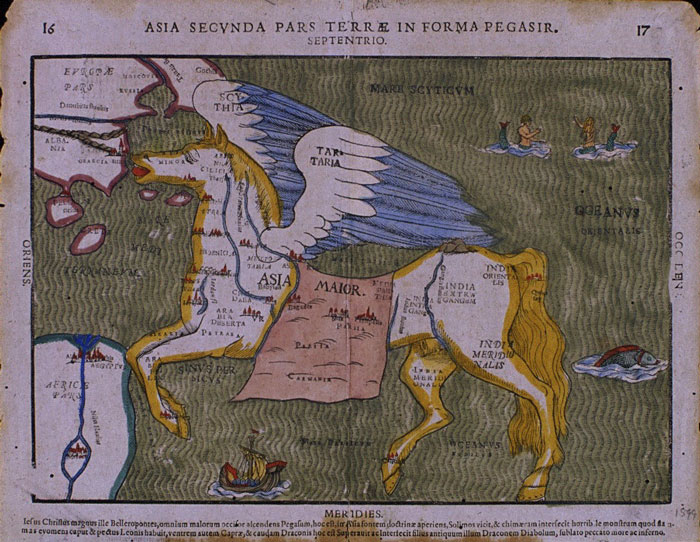In progress!
October 2, 2011 Sunday @ 76 Hillside
A geographical region is a product of (social) imagination, a utopia of sorts, always in the making. Maps are particularly powerful forms of spatial representation that illustrate this often dynamic, hard-to-nail-down aspect of landscapes. What map would express this better than Heinrich Bunting’s 1594 “Map of Asia in the shape of a winged horse"? (Asia secunda pars terrae in forma Pegasir). This gentleman's Itinerarium Sacra Scripturae (1581) included several maps of the Holy Lands but also this one, a map of Asia, idealized as the embodiment of Pegasus- becoming that continent of broad steppelands, pastoral nomads and horse-riding restless souls. This winged divine horse of Greek mythology figures the moving landscapes of Asia- transforms the bounded geographical entity into "boundless worlds" (Kirby 2009). Yale Library website calls this "pure fantasy" but of course I will disagree. This woodcut map is in fact a fairly accurate representation of Asia if we are able to think outside the scientific notions of cartographic representation. Doreen Massey also advocated the mobility of landscapes- even speaking of the geological bedrock of place, which we so commonly associate with groundedness and rootedness (Massey 2006).

"Heinrich Bunting’s 1594 “Map of Asia in the shape of a winged horse.” (Image source: Yale Libraries Map Collection)
Studying ancient landscapes, we are often reluctant to think of mobility of landscapes, both in terms of bodily movement across regions and with respect to the dramatic shifts of landscapes in the social imagination. New political configurations, environmental fluctuations, changing settlement trends, shifting use of natural resources and the dynamic character of roads, routes, river courses and trade networks all lead to subtle and not-so-subtle changes in the habitats of our dwelling in the long-term.
References
- Kirby, Peter Wynn (ed); 2009. Boundless worlds: an anthropological approach to movement. Berghahn Books.
- Massey, Doreen; 2006 "Landscape as a provocation: reflections on moving mountains" Journal of Material Culture 11: 33–48.
